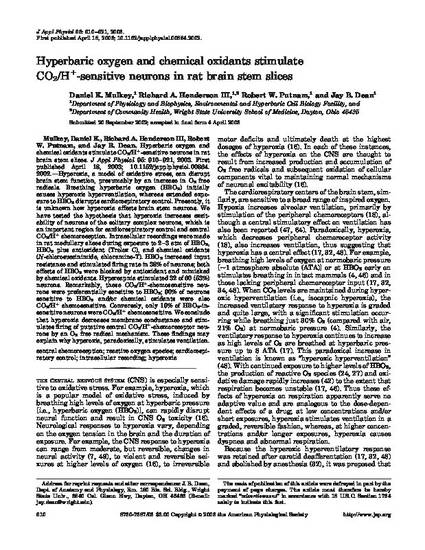
Hyperoxia, a model of oxidative stress, can disrupt brain stem function, presumably by an increase in O2 free radicals. Breathing hyperbaric oxygen (HBO2) initially causes hyperoxic hyperventilation, whereas extended exposure to HBO2disrupts cardiorespiratory control. Presently, it is unknown how hyperoxia affects brain stem neurons. We have tested the hypothesis that hyperoxia increases excitability of neurons of the solitary complex neurons, which is an important region for cardiorespiratory control and central CO2/H+ chemoreception. Intracellular recordings were made in rat medullary slices during exposure to 2-3 atm of HBO2, HBO2 plus antioxidant (Trolox C), and chemical oxidants (N-chlorosuccinimide, chloramine-T). HBO2 increased input resistance and stimulated firing rate in 38% of neurons; both effects of HBO2 were blocked by antioxidant and mimicked by chemical oxidants. Hypercapnia stimulated 32 of 60 (53%) neurons. Remarkably, these CO2/H+-chemosensitive neurons were preferentially sensitive to HBO2; 90% of neurons sensitive to HBO2 and/or chemical oxidants were also CO2/H+ chemosensitive. Conversely, only 19% of HBO2-insensitive neurons were CO2/H+ chemosensitive. We conclude that hyperoxia decreases membrane conductance and stimulates firing of putative central CO2/H+-chemoreceptor neurons by an O2 free radical mechanism. These findings may explain why hyperoxia, paradoxically, stimulates ventilation.
Available at: http://works.bepress.com/robert_putnam/40/
